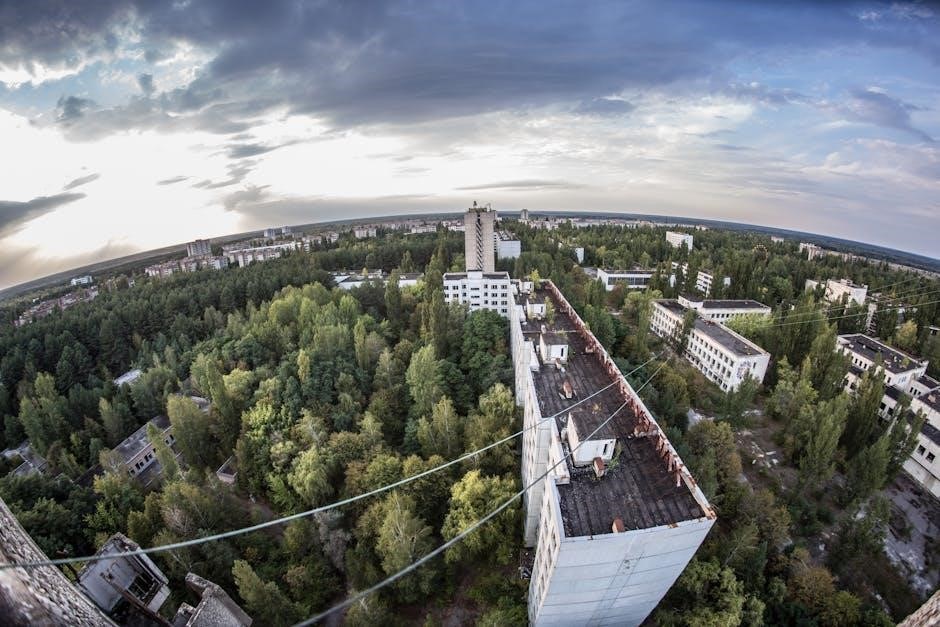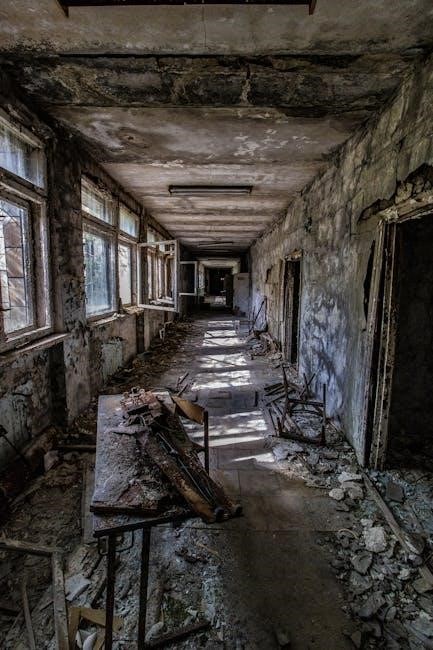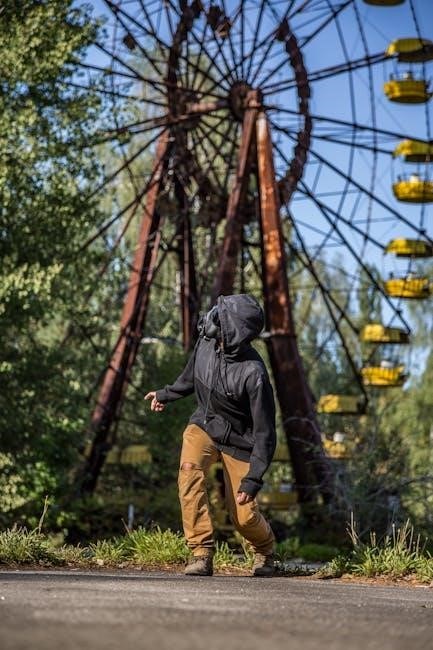voices of chernobyl pdf
“Voices of Chernobyl” by Svetlana Alexievich is a poignant collection of personal accounts from the 1986 nuclear disaster, offering a raw, emotional glimpse into its impact on individuals and communities. The book, available in PDF format, is a crucial historical document that captures the human side of the tragedy through oral histories, making it an essential read for understanding the disaster’s profound consequences.
1.1 Overview of the Book
“Voices of Chernobyl” by Svetlana Alexievich is a heart-wrenching oral history that captures the personal accounts of those affected by the 1986 Chernobyl nuclear disaster. The book presents monologues from survivors, liquidators, and local communities, offering a deeply human perspective on the tragedy. Available in PDF format, it provides a poignant and intimate look at the lives disrupted by the disaster. Through these firsthand narratives, Alexievich highlights the emotional toll, the loss of innocence, and the resilience of those who endured unimaginable hardship. The book serves as a vital historical document, preserving the voices of those impacted by one of the 20th century’s most catastrophic events.
1.2 The Author: Svetlana Alexievich
Svetlana Alexievich is a renowned Belarusian journalist and author, celebrated for her groundbreaking work in oral history. Her book, “Voices of Chernobyl,” showcases her unique approach to storytelling by giving voice to ordinary people affected by extraordinary events. A Nobel Prize laureate, Alexievich is known for her ability to weave together personal narratives into powerful collective histories. Through her meticulous interviews and emotional honesty, she captures the human experience of the Chernobyl disaster, providing a deeply personal and haunting account of its impact. Her work has been widely acclaimed for its raw authenticity and its ability to preserve the stories of those who lived through the tragedy.
1.3 The Importance of the Book
“Voices of Chernobyl” is a vital document that captures the human experience of the Chernobyl disaster through personal stories, making it an essential historical record. By presenting raw, emotional accounts, the book provides a unique perspective on the tragedy, emphasizing the personal and collective suffering of those affected. Its significance lies in preserving the voices of survivors, liquidators, and impacted communities, offering a profound understanding of the disaster’s emotional and societal consequences. Available in PDF format, the book ensures accessibility, allowing readers to engage with these critical oral histories and reflect on the lessons of Chernobyl for future generations.

Historical Context of the Chernobyl Disaster
The Chernobyl disaster occurred on April 26, 1986, at the RBMK reactor in Ukraine, contaminating vast areas of Europe and causing unprecedented environmental and human damage.
2.1 What Happened on April 26, 1986
On April 26, 1986, a catastrophic explosion occurred at the Chernobyl Nuclear Power Plant during a safety test, releasing massive amounts of radioactive materials into the atmosphere. The accident, triggered by a combination of human error and design flaws, led to the destruction of the reactor core and the release of more than 50 million curies of radionuclides. This event contaminated large areas of Europe, including Belarus, Ukraine, and Russia, and is regarded as the worst nuclear power plant accident in history, with severe and long-lasting environmental and health consequences.
2.2 The Immediate Aftermath
The explosion at Chernobyl on April 26, 1986, led to an immediate and devastating aftermath. The reactor core was destroyed, releasing radioactive materials into the atmosphere, contaminating vast areas, and spreading radioactive fallout across Europe. Emergency responders and firefighters rushed to the site, many succumbing to acute radiation syndrome. The nearby city of Pripyat was evacuated within 36 hours, leaving behind a ghost town. The radioactive plume spread across Ukraine, Belarus, and Russia, with traces reaching as far as Scandinavia. The disaster’s scale was unprecedented, marking the worst nuclear accident in history, with irreversible environmental and human consequences that unfolded in the weeks, months, and years following the event;
2.3 The Largest Technological Disaster of the 20th Century
The Chernobyl disaster stands as the most catastrophic technological failure of the 20th century, surpassing other major industrial accidents in scale and impact. The explosion released over 50 million curies of radioactive material, contaminating millions of acres of land and affecting millions of people. The disaster’s severity led to the immediate evacuation of 135,000 people from the surrounding area, creating a 30-kilometer exclusion zone that remains largely uninhabitable today. The economic, environmental, and human toll was immense, with Belarus alone losing 485 villages and settlements. This tragedy underscored critical failures in safety measures and governmental transparency, reshaping global perceptions of nuclear energy and safety protocols forever.

Personal Accounts and Oral Histories
Voices of Chernobyl presents deeply personal accounts of the 1986 disaster, sharing survivors’ and liquidators’ harrowing experiences and the enduring emotional toll on affected communities.
3.1 Survivors’ Stories
The survivors’ stories in Voices of Chernobyl reveal the human cost of the disaster, capturing the fear, loss, and resilience of those who lived through the catastrophe. Personal accounts describe the immediate chaos and confusion, the displacement from homes, and the long-term health struggles. These narratives provide a poignant glimpse into the lives of ordinary people facing extraordinary circumstances, offering a deeply emotional and intimate perspective on the disaster’s impact. The stories are raw and unfiltered, allowing readers to connect with the experiences of those affected, making the tragedy relatable and unforgettable.
3.2 Liquidators’ Experiences
The liquidators, those who worked to contain the Chernobyl disaster, share harrowing tales of sacrifice and peril in Voices of Chernobyl. Their accounts reveal the immense risks they took to mitigate the catastrophe, often without proper equipment or knowledge of the dangers. Many speak of the immediate and long-term health consequences, including radiation sickness and chronic illnesses. Their stories highlight the bravery and selflessness of these individuals, who put their lives on the line to protect others. The emotional and physical toll on the liquidators is deeply evident, making their experiences some of the most compelling and heartbreaking in the book.
3.3 The Emotional Toll on Affected Communities
The emotional toll on communities affected by Chernobyl, as documented in Voices of Chernobyl, is profound and far-reaching. Residents faced not only the immediate trauma of displacement but also long-term anxiety about health and uncertainty. The loss of homes, livelihoods, and a sense of security left deep scars. Many struggled with feelings of abandonment and betrayal by authorities, exacerbating their emotional pain. The book captures the collective grief and resilience, offering a poignant reminder of the human cost of the disaster. These personal narratives underscore the lasting psychological impact on those whose lives were forever altered by the catastrophe.

The Impact of Chernobyl on Belarus
The Chernobyl disaster devastated Belarus, with 485 villages lost, surpassing WWII devastation. The Voices of Chernobyl PDF highlights the national tragedy and its enduring effects on the population.
4.1 National Disaster and Loss
Chernobyl was a national catastrophe for Belarus, causing unprecedented loss. The disaster led to the displacement of hundreds of thousands and the contamination of vast areas of land. Entire communities were uprooted, and the country’s agricultural and industrial sectors suffered severely. The emotional toll was immense, with families separated and livelihoods destroyed. The Voices of Chernobyl PDF captures the harrowing experiences of survivors, revealing the depth of suffering and resilience. This section highlights the immediate and long-term consequences, emphasizing how the tragedy reshaped Belarus’s identity and future.
4.2 Comparison to WWII Devastation
The impact of Chernobyl on Belarus was likened to the devastation of World War II. During WWII, 619 villages were destroyed, along with their inhabitants. Chernobyl resulted in the loss of 485 villages and settlements, displacing thousands. The emotional and societal scars from both events share a common depth of trauma. The Voices of Chernobyl PDF highlights this parallel, illustrating how the disaster affected Belarus on a scale comparable to wartime. Personal accounts in the book reveal the shared sense of loss, grief, and resilience, drawing a poignant connection between these two defining events in the nation’s history.
4.3 The Long-Term Effects on the Population
The long-term effects of Chernobyl on Belarus’s population were profound and far-reaching. The disaster caused widespread health issues, including increased rates of cancer and thyroid diseases, particularly among children. Many survivors experienced psychological trauma and chronic illness. The Voices of Chernobyl PDF chronicles these struggles, offering personal accounts of lives forever altered. The contamination of land and water led to ongoing displacement, affecting generations. Economic hardship and social stigma further exacerbated the suffering. The book serves as a testament to the enduring impact of the disaster, highlighting the human cost of such a catastrophic event and its lasting legacy on the people of Belarus.

The Book’s Structure and Style
Voices of Chernobyl is structured as a collection of monologues, each offering a personal perspective on the disaster. The oral history approach creates an intimate, emotional narrative, capturing the raw experiences of survivors and liquidators in a poignant, unfiltered manner. The PDF format preserves this unique storytelling style, ensuring the voices of those affected are heard clearly and powerfully. Alexievich’s work is a masterful blend of individual testimonies, weaving together history, emotion, and reflection into a compelling and unforgettable account of the Chernobyl tragedy.
5.1 Use of Monologues
Svetlana Alexievich’s “Voices of Chernobyl” employs monologues to present deeply personal accounts of the disaster, offering a direct and emotional narrative. Each monologue captures the unique voice and experience of individuals affected by the tragedy, including survivors, liquidators, and scientists. This approach provides an intimate glimpse into the personal struggles and emotions of those impacted, creating a powerful and unforgettable portrayal of the event. The monologues are unfiltered and raw, allowing readers to connect with the human side of the disaster. The PDF format preserves the integrity of these oral histories, ensuring their emotional power and honesty resonate clearly with readers.
5.2 The Oral History Approach
The oral history approach in “Voices of Chernobyl” allows for a unique, unfiltered narrative that captures the raw emotions and experiences of those affected by the disaster. By compiling personal testimonies, Alexievich creates a vivid tapestry of stories that reflect the collective trauma and resilience of the people. This method ensures that the voices of ordinary citizens, firefighters, and liquidators are heard, providing a human-centric perspective often overlooked in historical analyses. The PDF version of the book maintains the authenticity of these accounts, making it an invaluable resource for understanding the personal and societal impact of the Chernobyl catastrophe.
5.3 Emotional Power and Honesty
The emotional power of “Voices of Chernobyl” lies in its unflinching honesty, as survivors share heart-wrenching accounts of loss, fear, and resilience. Alexievich’s use of oral histories creates an intimate connection, allowing readers to experience the tragedy through raw, personal narratives. The PDF version preserves the emotional depth, offering a poignant reflection on human suffering and survival. These stories, untouched by embellishment, provide a truthful portrayal of the disaster’s impact, making the book a deeply moving and unforgettable read. The honesty in these voices ensures that the human cost of Chernobyl is never forgotten.

Availability of “Voices of Chernobyl” in PDF
“Voices of Chernobyl” is widely available in PDF format, accessible through platforms like Perlego and popular eBook sites, ensuring readers can explore this vital work digitally.
6.1 Accessing the Book Digitally
Accessing “Voices of Chernobyl” digitally is straightforward, with multiple platforms offering the book in PDF and ePUB formats. Readers can find it on Perlego, which provides unlimited access to academic and non-fiction titles, including this essential work. Additionally, the book is available for download on popular eBook platforms, ensuring accessibility for a global audience. Many websites allow free downloads of the PDF version, making it easy for anyone interested in the Chernobyl disaster to explore Alexievich’s compelling oral histories. Digital access has made this crucial document widely available, preserving the stories of those affected for future generations.
6.2 Popular Platforms for Download
Several platforms offer “Voices of Chernobyl” in PDF format, catering to diverse reader preferences. Amazon provides the book as a Kindle download, while Google Books offers a preview and purchase options. Scribd and Project Gutenberg are other popular choices for accessing the PDF version. Additionally, the Internet Archive hosts free downloads, making it easily accessible. Many of these platforms ensure high-quality formats, preserving the book’s emotional depth and historical significance. Users can also explore additional features like adjustable fonts and bookmarking, enhancing their reading experience. Always verify the legality of downloads to support authors and publishers while enjoying this vital work on the Chernobyl disaster.
6.3 Legal and Free Sources
Accessing “Voices of Chernobyl” in PDF legally and for free is possible through reputable platforms. The Internet Archive offers a free download option, ensuring legal access to the book. Additionally, platforms like Perlego and Project Gutenberg provide free access to educational and historical texts, including this work. Many libraries also offer e-book lending services, allowing readers to borrow the PDF legally. Always opt for verified sources to avoid piracy and support the author’s work. These platforms make it easy to explore the book’s powerful narratives while adhering to copyright laws.

The Significance of “Voices of Chernobyl”
“Voices of Chernobyl” is a vital historical document, preserving personal stories and emotions from the disaster. Its oral history approach provides a deeply human perspective, making it indispensable for understanding the tragedy’s impact.
7.1 A Crucial Document of the Disaster
“Voices of Chernobyl” stands as a vital historical document, capturing the raw emotions and experiences of those affected by the 1986 nuclear catastrophe. By compiling personal testimonies, the book offers an intimate and unfiltered look at the disaster’s aftermath, providing readers with a deeper understanding of the human cost. The oral histories within its pages serve as a poignant reminder of the tragedy, ensuring that the voices of survivors, liquidators, and affected communities are not forgotten. This unique approach makes it an indispensable resource for anyone seeking to comprehend the full impact of the Chernobyl disaster.
7.2 Preserving History Through Personal Stories
“Voices of Chernobyl” preserves history by amplifying the personal stories of those directly impacted by the disaster. Through intimate monologues, the book captures the emotional and psychological toll on survivors, liquidators, and their families. These narratives provide a human dimension to the tragedy, transforming it from a historical event into a deeply relatable experience. By documenting individual struggles and memories, Alexievich ensures that the voices of those affected are immortalized, offering future generations a poignant reminder of the disaster’s far-reaching consequences. This approach not only honors the past but also underscores the importance of oral history in understanding collective trauma.
7.3 The Book’s Role in Understanding the Disaster

“Voices of Chernobyl” plays a vital role in understanding the disaster by presenting unfiltered, personal accounts that reveal the complexity of human experience during and after the tragedy. The book transcends traditional historical narratives by focusing on the emotional and psychological impact, offering readers a deeper connection to the events. Through its oral history approach, it provides insights into the societal, environmental, and personal ramifications of the disaster. This unique perspective not only educates but also humanizes the tragedy, making it an indispensable resource for comprehending the full scope of Chernobyl’s consequences and its lasting legacy on affected communities.

The Legacy of Chernobyl
The Chernobyl disaster leaves a lasting legacy as a cautionary tale about nuclear safety and human error, with its exclusion zone serving as a haunting reminder of its impact.
8.1 Lessons Learned
The Chernobyl disaster underscored critical lessons in nuclear safety, highlighting the importance of stringent safety protocols, transparent governance, and preparedness for emergencies. The catastrophe revealed how human error, design flaws, and inadequate safety measures can lead to devastating consequences. It also emphasized the need for international cooperation in addressing nuclear accidents, as the fallout affected multiple countries. These lessons have shaped modern nuclear regulations and safety practices globally, ensuring that such a tragedy is never repeated. The voices of survivors and experts in “Voices of Chernobyl” further stress the importance of learning from this tragedy to safeguard future generations.
8.2 The Exclusion Zone and Its Current State
The Chernobyl Exclusion Zone, a 30-mile radius around the damaged reactor, remains largely uninhabited due to high radiation levels. Despite this, parts of the zone have low enough radiation for limited human activity. Nature has reclaimed much of the area, with forests and wildlife flourishing in the absence of human presence. The zone is now a de facto wildlife reserve, offering a unique glimpse into post-disaster ecological recovery. However, the area still contains remnants of the disaster, including the sarcophagus covering Reactor 4 and abandoned settlements. Ongoing scientific research and monitoring continue to assess the zone’s safety and environmental transformation.
8.3 Memorials and Remembrance
The Chernobyl disaster is commemorated through various memorials and tributes, honoring the victims and their stories. The Chernobyl Museum in Kiev stands as a testament to the tragedy, showcasing artifacts and personal accounts. Memorials such as the “Wormwood Star” and “To Those Who Saved the World” statues symbolize the disaster’s impact. Annual ceremonies are held to remember the liquidators and civilians who lost their lives. These memorials serve as a poignant reminder of the catastrophe, ensuring that the lessons of Chernobyl are never forgotten. They also provide a space for reflection and remembrance, keeping the memories of the affected communities alive for future generations.

Svetlana Alexievich’s Other Works
Svetlana Alexievich is renowned for her oral history books like “Wars Unwomen” and “Second-Hand Time”, which explore human experiences during times of crisis and societal change.
9.1 “Wars Unwomen”
“Wars Unwomen” by Svetlana Alexievich explores the often overlooked experiences of women in war, capturing their personal stories and emotions through her signature oral history style. The book delves into the lives of women who served in the Soviet Army during World War II, revealing their struggles, sacrifices, and the societal expectations they faced. Alexievich’s work challenges the traditional heroic narratives of war by focusing on the intimate, emotional, and rarely spoken truths of women’s contributions. Like “Voices of Chernobyl”, this book is a powerful testament to the human cost of conflict, offering a unique perspective on history through personal testimonies.
9.2 “Second-Hand Time”
“Second-Hand Time” by Svetlana Alexievich is a profound exploration of the human experience during the collapse of the Soviet Union. Through a series of monologues, the book captures the emotional and psychological shifts of individuals grappling with the end of an era; Alexievich masterfully weaves together personal stories of loss, hope, and identity, offering a deeply intimate perspective on this pivotal moment in history. Like her work in “Voices of Chernobyl”, this book uses oral history to create a vivid tapestry of collective memory, highlighting the complexities of transition and the resilience of the human spirit in the face of monumental change.
9.3 Her Contribution to Oral History
Svetlana Alexievich’s work, including “Voices of Chernobyl”, has revolutionized the field of oral history by giving voice to ordinary people caught in extraordinary events. Her unique approach combines deep empathy with meticulous documentation, creating a powerful mosaic of personal narratives. By focusing on individual experiences, she humanizes historical events, making them relatable and emotionally resonant. Her contributions have set a new standard for storytelling, ensuring that the memories of those affected by significant events are preserved with authenticity and dignity. This method has earned her international acclaim and a Nobel Prize, solidifying her role as a pioneer in oral history.
“Voices of Chernobyl” remains a haunting yet vital account of the nuclear disaster, offering poignant insights into human resilience and tragedy. Its availability in PDF ensures accessibility, preserving a crucial historical narrative for future generations to reflect on and learn from.
10.1 The Enduring Relevance of “Voices of Chernobyl”
“Voices of Chernobyl” remains a vital and poignant account of the 1986 disaster, offering a deeply personal lens through which to understand its far-reaching consequences. The book’s oral history approach captures the raw emotions and experiences of survivors, liquidators, and affected communities, preserving their stories for future generations. Its availability in PDF format ensures accessibility, making it a crucial resource for those seeking to grasp the human toll of the tragedy. The book’s relevance endures as it serves as a reminder of the importance of learning from history and honoring the memories of those impacted by the disaster.
10.2 The Book’s Message for Future Generations
“Voices of Chernobyl” conveys a powerful message for future generations by documenting the personal and collective experiences of those affected by the disaster. Through its vivid oral histories, the book emphasizes the importance of remembering and learning from past mistakes. It serves as a warning about the dangers of technological hubris and the need for accountability. The availability of the book in PDF format ensures that its lessons are accessible to readers worldwide, fostering a deeper understanding of the consequences of the Chernobyl disaster and the resilience of the human spirit in the face of catastrophe.